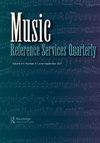Sharing the Joy of Music: A Music Cataloger’s Guide to Training Library Staff with Limited Music Expertise
Q2 Arts and Humanities
引用次数: 0
Abstract
ABSTRACTCountless academic libraries are unable to commit staff time to handle the multiple workflows required by a music library, such as ordering, procurement, and cataloging. Music librarians often rely on support from staff in other departments with limited musical backgrounds. Drawing from resources offered by the central library, a University of Tennessee music cataloger created guidelines for training non-musical library staff in identifying various musical formats. The training was meant to improve the workflow of music materials from acquisitions, cataloging, and processing departments. The training focused on illustrating the differences between a variety of commonly found musical score formats. The goal was to increase staff effectiveness and reduce errors in ordering and processing music materials. Ultimately, the training enabled library staff to identify best options and apply sound judgment when fulfilling order requests. These guidelines included illustrations with examples of different formats with cover images, title pages, music notation pages, and a brief bibliographic description of MARC fields 100, 245, 240, 250 and 300. By evaluating bibliographic records from WorldCat and showing physical examples of various musical manifestations, non-musical library staff were able to contribute more effectively to the operations of the music library. Furthermore, during the process of training and following up with staff, it became clear that the need for basic music training was greater than initially perceived and that numerous other units within the library needed this training. This paper offers guidelines for music library training from both the University of Tennessee and the music library literature.KEYWORDS: Music library traininglibrary staff cross-trainingmusic formatsmusic catalogingmusic acquisitionsmusic processingmusic library systems AcknowledgmentsThe authors would like to thank their supportive families, especially their spouses Jan Rosinski and Miroslav Hristov, for holding down the fort during several evenings, weekends, and holidays, so that the authors would have the time needed to prepare this manuscript.Disclosure statementNo potential conflict of interest was reported by the author(s).Notes1. Liz Hart and Ruth Hellen, “Music for the Terrified,” Fontes Artis Musicae 47, no. 1 (January-March 2000): 22–26.2. Geoffrey Thomason, “Urtexts, URL, and a Trip to the Russian Optician,” Brio: Journal of the United Kingdom Branch of the International Association of Music Libraries 38, no. 2 (2001): 31–40.3. Amelie Roper, “Bridging the Gap: Developing Professional Education for Music Library Staff in the United Kingdom and Ireland,” Fontes Artis Musicae 59, no. 2 (2012): 168–178.4. Ibid, pp.168–9.5. Ibid, p.178.6. Anna Craft, “Onboarding and Training New Electronic Resources Personnel in Libraries: An Overview of Literature and Resources,” Serials Review 47, no. 3–4 (2001): 182–186.7. Valeria Bond Hodge, Acquisitions Unit Manager for the University of Tennessee Libraries, conversation with Wanda Rosinski, Music Cataloger for UT Libraries, Summer 2019.8. Nathalie Hristov and Chris Durman, conversation with Wanda Rosinski, Music Cataloger for UT Libraries, December 2020.9. Valeria Bond Hodge, Acquisitions Unit Manager for the University of Tennessee Libraries, e-mail to Wanda Rosinski, Music Cataloger for UT Libraries, January 26, 2022.分享音乐的乐趣:音乐编目员培训音乐专业知识有限的图书馆工作人员的指南
无数的学术图书馆无法保证工作人员有足够的时间来处理音乐图书馆所需要的多个工作流程,比如订购、采购和编目。音乐图书管理员通常依靠其他部门的工作人员的支持,他们的音乐背景有限。根据中央图书馆提供的资源,田纳西大学的一位音乐编目员制定了指导方针,培训非音乐馆员识别各种音乐格式。培训的目的是改善音乐资料的工作流程,从收购,编目,和处理部门。培训的重点是说明各种常用乐谱格式之间的差异。目标是提高工作人员的效率,减少订购和处理音乐材料的错误。最终,培训使图书馆工作人员能够确定最佳选择,并在满足订单请求时应用合理的判断。这些指南包括不同格式的插图、封面图片、标题页、乐谱页,以及MARC字段100、245、240、250和300的简短书目描述。通过评估来自WorldCat的书目记录和展示各种音乐表现形式的实物例子,非音乐图书馆工作人员能够更有效地为音乐图书馆的运作做出贡献。此外,在培训和跟踪工作人员的过程中,很明显,对基本音乐培训的需求比最初想象的要大,图书馆内许多其他单位都需要这种培训。本文从田纳西大学和音乐图书馆文献两方面为音乐图书馆培训提供指导。关键词:音乐图书馆培训图书馆工作人员交叉培训音乐格式音乐编目音乐获取音乐处理音乐图书馆系统鸣谢作者要感谢他们的支持家庭,特别是他们的配偶Jan Rosinski和Miroslav Hristov,在几个晚上,周末和假期坚持下来,使作者有时间准备这篇手稿。披露声明作者未报告潜在的利益冲突。莉兹·哈特和露丝·海伦,《恐惧的音乐》,Fontes Artis Music第47期,第47期。1(2000年1月至3月):22-26.2。Geoffrey Thomason,“Urtexts, URL, and a Trip to the Russian Optician,”Brio: Journal of the International Association of Music Libraries, 38, no。2(2001): 31-40.3。Amelie Roper,“弥合差距:在英国和爱尔兰发展音乐图书馆工作人员的专业教育”,Fontes Artis Musicae, 59, no。2(2012): 168-178.4。如上,pp.168 - 9.5。如上,p.178.6。安娜·克拉夫特,“图书馆电子资源新员工的入职与培训:文献与资源综述”,《学术评论》第47期。3-4(2001): 182-186.7。瓦莱里娅·邦德·霍奇,田纳西大学图书馆收购部门经理,与万达·罗辛斯基对话,UT图书馆音乐编目员,20119.8夏季。娜塔莉·赫里斯托夫和克里斯·杜尔曼,与万达·罗辛斯基对话,音乐编目为UT图书馆,2020.9年12月。瓦莱里娅·邦德·霍奇,田纳西大学图书馆的收购部门经理,于2022年1月26日给田纳西大学图书馆音乐编目员万达·罗辛斯基的电子邮件。
本文章由计算机程序翻译,如有差异,请以英文原文为准。
求助全文
约1分钟内获得全文
求助全文
来源期刊

Music Reference Services Quarterly
Arts and Humanities-Music
CiteScore
0.40
自引率
0.00%
发文量
30
期刊介绍:
Music Reference Services Quarterly is a refereed journal covering all aspects of the management and use of music collections and services in academic, orchestra, public, conservatory, and performing/fine arts libraries, as well as archives and museums. The Journal emphasizes research related to administration and management, bibliographic instruction, collection development, digital audio delivery, electronic resources, facilities, music librarianship education, preservation of music materials, reference services, cataloging, and bibliographies relating to printed music and audio-visual materials. The Journal publishes conceptual papers, literature reviews, practical case studies and opinion pieces. Regular columns include electronic resource reviews, book reviews and interviews.
 求助内容:
求助内容: 应助结果提醒方式:
应助结果提醒方式:


